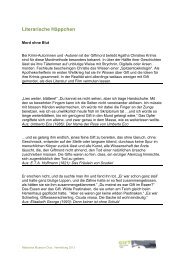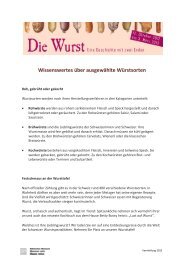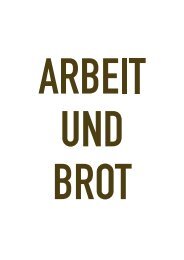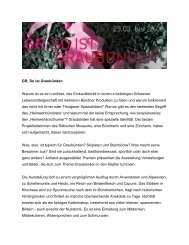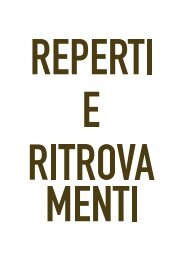Finds and Findings - Raetisches Museum - Kanton Graubünden
Finds and Findings - Raetisches Museum - Kanton Graubünden
Finds and Findings - Raetisches Museum - Kanton Graubünden
Create successful ePaper yourself
Turn your PDF publications into a flip-book with our unique Google optimized e-Paper software.
<strong>Finds</strong> in Mountains <strong>and</strong> Waters Single finds, which<br />
were discovered in the mountains as well as on<br />
mountain passes, are numerous. Hunters or herdsmen<br />
could have lost these. However, these finds<br />
could also be evidence of Bronze Age Alpine farming.<br />
In individual cases they might be votive offerings<br />
to a mountain deity.<br />
For example swords, lances <strong>and</strong> other objects are<br />
found just as often in waters, in rivers, lakes or also<br />
in or around springs. Whether these are lost objects<br />
or votive offerings to a water deity is unclear. Two<br />
bronze axes near a spring above Rueun or several<br />
sword finds, a dagger, <strong>and</strong> a pin in the spring-water<br />
tapping of St.Moritz-Bad could have been votive<br />
offerings to a spring deity.<br />
The spring-water tapping system of St.Moritz is a<br />
highly interesting wooden structure. It consists of a<br />
log chest <strong>and</strong> a plank chest; inside there are two<br />
vertical pipes as well as a climbing device. Everything<br />
is made of larch wood <strong>and</strong> dates back to the middle<br />
of the 15th century B.C.<br />
Jewellery In the Bronze Age bronze pins were very<br />
often worn as garment fasteners. Coarse linen<br />
fabrics were fastened with these. After the Late Bronze<br />
Age fibulae replaced the bronze pins. Additional<br />
ornamental objects were bracelets <strong>and</strong> finger rings,<br />
necklaces with amber <strong>and</strong> small bronze roulettes or<br />
thorn discs, buttons made of bone <strong>and</strong> bronze, which<br />
were probably sewn onto fabric. The intended use of<br />
deer horn roses is uncertain. The boar’s tusk lamella<br />
may have served as a wrist-guards for archers.<br />
The most significant object found is the beautifully<br />
decorated disc-headed pin from Falera-Muota. It is<br />
85 cm long. Because of its size it is unlikely that it<br />
was worn by a woman. It could have been used as a<br />
cult or prestige object, for example to decorate a<br />
wooden statue.<br />
Bronze <strong>and</strong> amber jewellery was a privilege of the<br />
upper class. Jewellery pieces as grave goods<br />
were supposed to ensure the social position of the<br />
deceased in the hereafter. There were certainly also<br />
ornaments made of simple materials, which however<br />
have not survived.<br />
14 15



